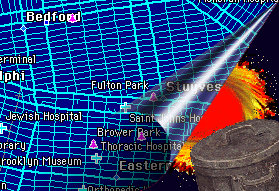
The Neighborhood Project(s)
Michael J. Weiss
Joel Garreau
- Racial Geography as Destiny
- The legacy of American apartheid is the greatest determining factor in the economic differences between 'the races'.
- Geography,
Poverty and Politics
Scratch Me, and I Bleed Champaign:Geography, Poverty and Politics in the Heart of East
Central Illinois Jonathan Sterne Bad Subjects, Issue #17 November 1994 Copyright
Race & Place
For Blacks and Whites, living together in racially integrated neighborhoods
helps to improve attitudes about one another and behavior toward other races,
according to researchers in the recent book, "Race & Place," published by
Cambridge University Press. However, the scholars show that both groups still
differ in how they view race-related issues.
NPR - Segregation in Cities
The latest census numbers show that the nation is becoming more diverse, but cities remain racially segregated. Whites are more likely to live among whites, blacks are more likely to live among blacks ... and on it goes for other ethnic groups. Fair housing advocates say this is proof that racial discrimination laws need to be enforced, while others say people simply want to live among others of similar culture and outlook. Juan Williams and guests examine why U.S. cities are so segregated on a special broadcast from the Newseum in Arlington, Virginia.
A Visual Representation of Racial Segregation - Blacks in Los Angeles- William Bowen. Cal State Northridge
Massey
& Denton
"During the 1970s and 1980s a word disappeared from the
American vocabulary," begins American Apartheid ". . . That word was segregation."
But the practice of segregation certainly has not disappeared, as Douglas
S. Massey and Nancy A. Denton glaringly expose. One-third of all American
blacks live in one of just 16 urban areas, in neighborhoods so racially
segregated they have almost no chance at interracial contact. The authors
argue that segregation--and disassocation from not only other cultures,
but other ways of life--is at the root of many problems facing African-Americans
today.
Quinn &
Pawarasat
(UWM ETI)
The UWM researchers offer a definition that measures the
percentage of residents in a metro area who live on blocks that are at
least 20% black and 20% white - with the remaining 60% made up of any
combination of black, white or other ethnicity.
Using that approach, Detroit rises from 100th, the least integrated of the 100 largest areas in the old index, to 57th, and Cleveland jumps from 94th to 36th. No city gets a bigger boost than Memphis, Tenn., which rises from 76th on the traditional index to fifth.
Race
& Home Ownership 1900-1990
Collins & Margo
The historical evolution of racial differences in labor incomes has received
considerable attention from economists. In contrast to labor incomes,
far less attention has been paid to the historical evolution of racial
differences in wealth. This scholarly neglect is unfortunate because racial
differences in wealth were and still are much larger than racial
differences in labor incomes and also because wealth per se is an important
determinant of living standards, independent of earnings.
David Brooks